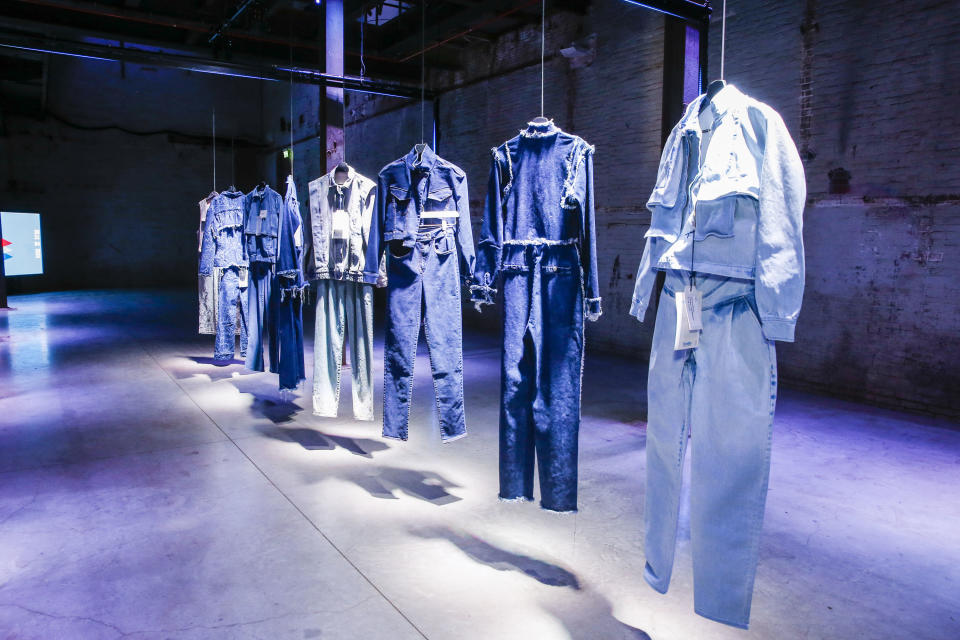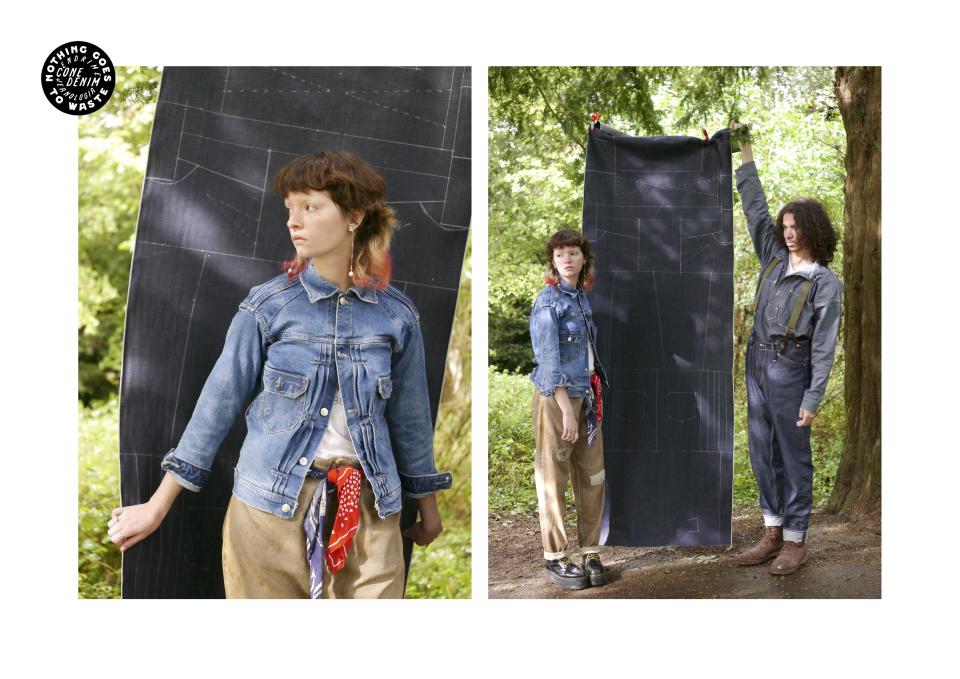Kingpins Leans Into Circularity, Cotton Alternatives in Denim as Costs Soar

AMSTERDAM — After two years exchanging swatches and Zoom calls, the mood was ebullient as textile mills, chemical companies and fiber producers came together at the latest edition of denim supply chain event Kingpins Amsterdam.
Founder Andrew Olah expressed satisfaction with this edition, which saw some 1,226 visitors from 625 companies in 39 countries visit the 87 exhibitors present at the two-day show — despite the absence of a majority of U.S.-based denim companies and the reduced size of team traveling, according to an initial tally by the organizers.
More from WWD
But beneath the sea of indigo novelties on display at SugarCity, a decommissioned 19th-century sugar factory turned exhibition venue, the issues they were addressing were not recent, according to industry veteran Olah.
“The denim industry is like going constantly to a psychiatrist, talking about [yourself] and what [you] could do better,” he said.
With panel discussions on post-consumer recycling, ethical practices across the supply chain, and greenwashing, the denim industry continues to push ahead with solutions — material and systemic.
The strongest undercurrent of the season was circularity, especially as scarcity and rising costs of raw materials are starting to make their effects felt.

Team Peter Stigter/Courtesy of Kingpins
Asking what would happen should gasoline become unavailable was the start of Offuel, an array of chemical auxiliaries for denim finishing sourced by turning to discarded plastic and food waste, explained Alberto De Conti, head of marketing and fashion division at 100-year-old German chemical firm Rudolf Group.
“People aren’t surprised by turning PET [plastic] bottles into cloth anymore, but they’re surprised by game changers like our recycling the sole of shoes,” a recently available technology for Gama Recycle, concurred Halil Ölçal, an executive at this Turkey-based yarn manufacturer, which works with the likes of PVH, Adidas and Nike.
With the reuse of post-industrial off-cuts back into the production chain now a widespread practice, on par with reduced water consumption, it was turning post-consumer goods into new resources that was top of mind.
“Finding a way to increase the circular economy is the most important thing we should be doing,” said Andrea Venier, managing director of textile chemical specialist Officina39, which has developed Recycrom, a dye made from post-consumer cellulose fibers such as cotton and lyocell.
The company teamed with Cocircular Lab, founded by designer Adriana Galijasevic, for the Circular Exploration project, which was presented at the Amsterdam Denim Days as a feasibility demonstration on what a circular textile lifecycle could look like and “help understand what is [the industry’s] final goal,” according to Venier.
A major hurdle is blended fibers, such as cotton and polyester mixes, which cannot at this point be separated on an industrial scale. This is what fiber firm Unifi is working on, said Umair Iftikhar, its country head of sales and market development for Asia Pacific.
That said, the billions of plastic bottles in landfills and turning up in bodies of water across the world still need to be addressed, he noted, saying it felt like a major challenge, even ahead of microplastics — a recurring question from brands.
Soaring cotton prices are also leveling the playing field for alternatives that were previously priced out. Take the biotech fabrics from Pakistan-based vertically integrated manufacturers Naveena Denim Mills, which are made from the stalks and stems left over from hemp cultures, or Lenzing’s specialty fibers like Refibra and lyocell.
“What you see around [Kingpins] is that people are looking at what other fiber alternatives exist that support their sustainable goals. The orientation of denim has always been very strong toward cotton [but] we are [no longer] a one-fiber world. And I think the denim industry is really leading at looking at alternatives around circularity,” said Tricia Carey, director of global business development, apparel, at Lenzing.
“Eco-design or responsible design literally starts with us [at the fiber level], then the fabric, finishing the garments, then consumers,” said Ebru Ozaydin, strategic marketing director, denim and ready-to-wear at The Lycra Company, which presented a new Adaptiv fiber that adapts its elasticity to provide comfort and maintain shape at rest and in motion, and the Dual Comfort technology, which includes the T400 “EcoMade” fiber.
But growing costs have taken a toll on sustainable leanings in brands, too, according to a number of exhibitors. “Everything is going up, except retail prices,” noted De Conti, echoing the sentiment of many at Kingpins for whom going green still feels like Catch-22, stuck between brands looking to cut costs and consumers for whom price remains the main factor in purchases.

Courtesy of Cone Denim
Having all the options on the menu made easier for brands to arbitrate how they want to approach sustainability, said Cone Denim’s design director Pierette Scavuzzo. But with costs rising across the board even a 5 percent upcharge, say, to switch from conventional spandex to the biodegradable Roica V550 from Japanese manufacturer Asahi Kasei can derail good intentions, said managing director Kevin Reardon.
Case in point: the decade-long availability of technologies such as ozone bleaching.
“Brands are sleeping. As technology producers, we are pushing as much as possible, helping them understand the possibilities but the ones who have the most influence are the consumers, especially the new generation who has access to information and can identify greenwashing,” said Alberto Lucchin, marketing executive at garment finishing technologies specialist Tonello, which showcased its three-in-one industrial washing machines featuring this, but also dye “infusions” made from food scraps.
Could the way out be consumer demands?
“I wish I could say the opposite. But I’m not feeling [a strong appetite for sustainability and transparency] from the consumers. I think some consumers definitely are interested in the quality of their brands. But then there are companies like Shein [where everything is opaque]. And their business is just growing,” Olah said.
Speaking after a panel on ethical practices, he cautioned bad faith actors that “the supply chains are slowly organizing themselves, have human rights that have to be maintained — and the sanctity of contracts is part of that — and they can’t make anything without one.”
Despite the road ahead, the Kingpins founder felt a denim industry that is “really committed to sustainability…transparency…and doing the right thing,” could be an agent of change across the whole of fashion.
“These two years of COVID-19 gave us a unique opportunity to pause and reflect. And it was also a unique opportunity to step out of [the cycle] of ruthless, continuous pressure on delivery. The feeling after these two days of physical meetings at Kingpins [Amsterdam] is that returning to a physical format showcased [the industry’s] openness to have these conversations,” said De Conti.
Sign up for WWD's Newsletter. For the latest news, follow us on Twitter, Facebook, and Instagram.

